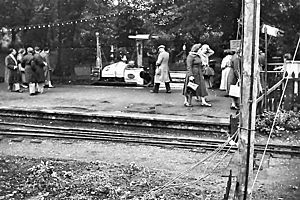Far Tottering and Oyster Creek Branch Railway facts for kids
The Far Tottering and Oyster Creek Branch Railway was a special miniature railway with a track that was 15 inches wide. It was created by a famous artist named Rowland Emett. This railway was known for its funny and imaginative design, showing a whimsical look at British country life. It was similar to the creative and often silly inventions drawn by other artists like Heath Robinson and Rube Goldberg. The idea for the railway first appeared in cartoons in Punch magazine in 1939.
Contents
The Railway at the Festival of Britain
This unique railway was chosen to be a big attraction at the 1951 Festival of Britain. The festival was a huge event held in London. The "Far Tottering and Oyster Creek Branch Railway" was about a third of a mile long. It carried over two million passengers through the Battersea Pleasure Gardens, giving them a fun and memorable ride.
Meet the Locomotives
There were three very special locomotives (train engines) that ran on this railway:
- No. 1 Nellie: This engine looked like a traditional saddle tank locomotive.
- No. 2 Neptune: This one was very unusual, designed to look as much like a paddle steamer (a boat with big wheels on the side) as it was a train.
- No. 3 Wild Goose: This engine was supposedly made from parts of an airship, making it truly one-of-a-kind!
These engines were built by Harry Barlow, following Rowland Emett's amazing designs. They used diesel engines that were left over from the war. The chassis (the frame and wheels) for Neptune was later used for another miniature railway engine called Prince Charles at the Lakeside Miniature Railway in Southport.
How the Railway Operated
The railway track was a single line with sharp curves and tunnels. To make sure trains didn't crash, they used a special system. Imagine each train was like a "token." If a driver saw another train safely in the platform next to them, it meant it was safe for their train to go. Three trains could be running at the same time, with one at each of the two stations and one moving between them.
A Sad Event in 1951
On July 11, 1951, a sad event happened. Two trains, both full of passengers, came towards each other on the single track near Oyster Creek station. Sadly, one person died and several others were hurt. It's not fully known exactly what caused this to happen. There wasn't a big official investigation, but there were some questions asked in Parliament about the incident.
Later Years and Closure
After the Festival of Britain ended, the Pleasure Gardens became part of Battersea Park. The railway kept running in the same spot until 1953. Then, it was moved to a different part of the park and renamed the Festival Gardens Railway.
In its new location, the railway was about 840 yards (760 meters) long. It ran from a station near the Queen's Gate, alongside the Eastern and Northern Carriage Drives, all the way to a station at Chelsea Bridge. There was also a small stop, called a "halt," at the Funfair. The railway continued to operate with other Barlow-built locomotives until 1975. It closed down partly because the funfair itself was becoming less popular. Today, you can still see a small part of the railway's cutting (a dug-out section of track) near the tennis courts in the park.



